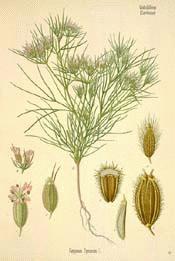
Botanical.com Home Page

|
Cumin
(Cuminum cyminum)
Click on graphic for larger image
|
Cumin
Botanical: Cuminum cyminum (LINN.)
Family: N.O. Umbelliferae
---Synonym---Cumino aigro (Malta).
---Part Used---Fruit.
---Habitat---Cumin, besides being used medicinally, was in the Middle Ages one of the commonest spice of European growth. It is a small annual, herbaceous plant, indigenous to Upper Egypt, but from early times was cultivated in Arabia, India, China, and in the countries bordering on the Mediterranean.
---Description---Its stem is slender and branched, rarely exceeding 1 foot in height and somewhat angular. The leaves are divided into long, narrow segments like Fennel, but much smaller and are of a deep green colour, generally turned back at the ends. The upper leaves are nearly stalkless, but the lower ones have longer leaf-stalks. The flowers are small, rose-coloured or white, in stalked umbels with only four to six rays, each of which are only about 1/3 inch long, and bloom in June and July, being succeeded by fruit - the so-called seeds - which constitute the Cumin of pharmacy. They are oblong in shape, thicker in the middle, compressed laterally about 5 inch long, resembling Caraway seeds, but lighter in colour and bristly instead of smooth, almost straight, instead of being curved. They have nine fine ridges, overlapping as many oil channels, or vittae. The odour and taste are somewhat like caraway, but less agreeable.
---History---Cumin is mentioned in Isaiah xxvii. 25 and 27, and Matthew xxiii. 23, and in the works of Hippocrates and Dioscorides. From Pliny we learn that the ancients took the ground seed medicinally with bread, water or wine, and that it was accounted the best of condiments. The seeds of the Cumin when smoked, were found to occasion pallor of the face, whence the expression of Horace, exsangue cuminum, and Pliny tells us that the followers of the celebrated rhetorician Porcius Latro employed it to produce a complexion such as bespeaks application to study.
Cumin also symbolized cupidity among the Greeks: Marcus Aurelius was so nicknamed because of his avarice, and misers were jocularly said to have eaten Cumin.
In the thirteenth and fourteenth centuries, when it was much in use as a culinary spice, its average price in England per lb. was 2d., equivalent to 1s. 4d. at the present day.
Cumin has now gone out of use in European medicine, having been replaced by Caraway seed, which has a more agreeable flavour, but it is still used to some extent in India, in native medicine. Its principal employment is in veterinary medicine and as an ingredient in curry powder, for which purposes it is imported from Bombay and Calcutta, Morocco, Sicily and Malta. It is commonly sold in Malta, where they call it cumino aigro (hot Cumin), to distinguish it from Anise, which they term cumino dulce, or sweet Cumin.
[Top]
---Cultivation---Although we get nearly all our supplies from the Mediterranean, it would be perfectly feasible to grow Cumin in England, as it will ripen its fruit as far north as Norway. It is, however, rarely cultivated here, and seeds are generally somewhat difficult to obtain.
They should be sown in small pots, filled with light soil and plunged into a very moderate hot bed to bring up the plants. These should be hardened gradually in an open frame and transplanted into a warm border of good soil, preserving the balls of earth which adhere to the roots in the pots. Keep clean of weeds and the plants will flower very well and will probably perfect their seeds if the season should be warm and favourable.
The plants are threshed when the fruit is ripe and the 'seeds' dried in the same manner as Caraway.
---Constituents---The strong aromatic smell and warm, bitterish taste of Cumin fruits are due to the presence of a volatile oil which is separated by distillation of the fruit with water, and exists in the proportion of 2 to 4 per cent. It is limpid and pale yellow in colour, and is mainly a mixture of cymol or cymene and cuminic aldehyde, or cyminol, which is its chief constituent.
The tissue of the fruits contains a fatty oil with resin, mucilage and gum, malates and albuminous matter, and in the outerseed coat there is much tannin. The yield of ash is about 8 per cent.
---Medicinal Action and Uses---Stimulant, antispasmodic, carminative. The older herbalists esteemed Cumin superior in comforting carminative qualities to Fennel or Caraway, but on account of its very disagreeable flavour, its medicinal use at the present day is almost confined to veterinary practice, in which it is employed as a carminative.
Formerly Cumin had considerable repute as a corrective for the flatulency of languid digestion and as a remedy for colic and dyspetic headache. Bruised and applied externally in the form of a plaster, it was recommended as a cure for stitches and pains in the side caused by the sluggish congestion of indolent parts, and it has been compounded with other drugs to form a stimulating liniment.
Bay-salt and Cumin-seeds mixed, is a universal remedy for the diseases of pigeons, especially scabby backs and breasts. The proportions of the remedy are: 1/4 lb. Baysalt, 1/4 lb. Common Salt, 1 lb. Fennel-seeds, 1 lb. Dill-seeds, 1 lb. Cumin-seeds, 1 OZ. Assafoetida; mix all with a little wheaten flour and some fine-worked clay; when all are well beaten together, put into two earthen pots and bake them in the oven. When cold, put them on the table in the dove-cote; the pigeons will eat it and thus be cured.
Common Name Index
A MODERN HERBAL Home Page
Bear in mind "A Modern Herbal" was written with the conventional wisdom of the early 1900's. This should be taken into account as some of the information may now be considered inaccurate, or not in accordance with modern medicine.
© Copyright Protected 1995-2025 Botanical.com
|

